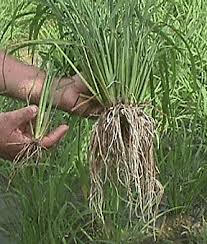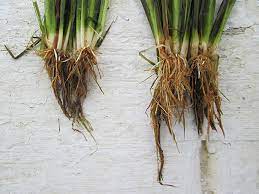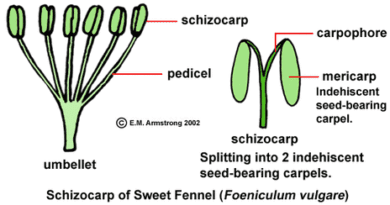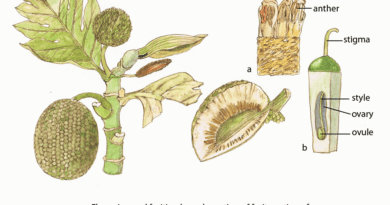Rice Roots: Economic Importance, Uses and By-Products
Rice roots are essential components of the rice plant (Oryza sativa) and play a crucial role in anchoring the plant to the soil, absorbing water and nutrients, and providing support for the overall growth and development of the plant.
They are specialized structures that are adapted to the rice plant’s growth in aquatic or semi-aquatic environments, such as flooded paddy fields. Rice roots consist of various components, including the primary root, lateral roots, root hairs, and root tips.
The primary root emerges from the seed during germination and serves as the main axis of root growth. Lateral roots branch off from the primary root, increasing the surface area for nutrient and water absorption.
Root hairs are tiny, finger-like projections that emerge from the surface of the root and greatly increase the root’s absorptive capacity.
Rice roots anchor the plant securely in the soil, preventing it from being uprooted by wind or water movements. Root hairs and the surface of the root actively absorb water and essential nutrients, such as nitrogen, phosphorus, and potassium, from the soil.
The Economic Importance and Uses of Rice Roots

Rice roots play a significant role in the growth, development, and overall economic importance of the rice plant.
Here are some of the key economic uses and benefits of rice roots:
1. Nutrient Uptake: Rice roots are responsible for absorbing essential nutrients from the soil, contributing to the plant’s overall health and growth. Nutrients such as nitrogen, phosphorus, and potassium are crucial for rice cultivation. Proper nutrient uptake leads to higher yields and better crop quality.
2. Water Uptake and Regulation: Rice roots absorb water from the soil, maintaining adequate moisture levels for the plant’s growth. Efficient water uptake is essential for rice cultivation, particularly in flooded or submerged paddy fields. This characteristic makes rice a suitable crop for wetland agriculture.
3. Soil Erosion Prevention: The extensive root system of rice plants helps bind soil particles together, reducing soil erosion and improving soil structure. This is especially important in areas with heavy rainfall and susceptible to erosion.
4. Carbon Sequestration: Rice roots contribute to carbon sequestration in the soil, helping mitigate climate change by storing carbon dioxide from the atmosphere in the form of organic matter in the soil.
5. Erosion Control: The dense network of rice roots stabilizes the soil, preventing landslides and soil erosion in hilly or sloped areas.
6. Habitat for Soil Microorganisms: Rice roots create a microenvironment around them that supports beneficial soil microorganisms. These microorganisms enhance nutrient availability and contribute to soil health.
7. Phytoremediation: Rice roots have the ability to take up and accumulate certain heavy metals and contaminants from the soil, making them useful for phytoremediation of polluted soils. For instance, certain rice varieties can be grown in contaminated areas to help clean up the soil.
8. Livelihoods and Economic Growth: Rice is a staple food for more than half of the world’s population, providing a significant source of sustenance and livelihoods for millions of people. Rice cultivation and processing create employment opportunities in rural areas, contributing to local economies.
9. Cultural and Culinary Importance: Rice is a fundamental component of many cuisines worldwide and holds cultural significance in various societies. Its cultivation and consumption contribute to culinary traditions and local economies tied to food production.
10. Biogas Production: Rice roots, when submerged in waterlogged paddy fields, create anaerobic conditions conducive to the production of methane gas. This gas can be collected and used as a renewable energy source for cooking, heating, and electricity generation. Biogas production from rice fields contributes to rural energy self-sufficiency and reduces reliance on non-renewable fuels.
12. Livestock Feed: Rice roots can serve as a nutritious feed source for livestock, particularly for animals like cattle and pigs. After rice harvesting, the leftover roots and plant residues can be used as animal feed, reducing feed costs and contributing to the livestock industry.
13. Erosion Management in Coastal Areas: In coastal regions, rice cultivation can help stabilize shorelines and protect against erosion due to tidal action and storm surges. The extensive root system of rice plants helps anchor soil and prevent coastal erosion, contributing to the protection of valuable land and infrastructure.
Read Also: 34 Amazing Benefits of Paw-Paw (Papaya) Fruit and Leaves
14. Biofuels and Bioproducts: Researchers are exploring the potential of utilizing rice roots for biofuel production. Rice roots contain complex carbohydrates and other organic materials that can be converted into biofuels like ethanol through fermentation processes. Additionally, these root-based materials can be used to produce bioplastics and other bio-based products.
15. Traditional Medicine and Herbal Remedies: In some cultures, rice roots have been used in traditional medicine for their potential health benefits. Extracts from rice roots are believed to possess antioxidant, anti-inflammatory, and other therapeutic properties, leading to the development of herbal remedies and health supplements.
16. Research and Biotechnology: The study of rice roots provides insights into plant growth, nutrient uptake, and soil interactions. Research on rice roots has led to the development of improved rice varieties with enhanced root traits, such as deeper and more efficient root systems. These traits contribute to higher yields, better drought tolerance, and improved nutrient utilization.
17. Wastewater Treatment: Rice fields can be used as constructed wetlands for treating wastewater and nutrient-rich effluents. The roots and associated microbial communities help remove pollutants and nutrients from the water, making rice fields an environmentally friendly option for wastewater treatment.
18. Education and Awareness: Understanding the importance of rice roots in sustainable agriculture and ecosystem health can lead to increased awareness and adoption of practices that support soil conservation, water management, and overall environmental stewardship.
The Products and By-products That Can Be Derived From Rice Roots

Rice roots, like those of other plants, contain various compounds that can be extracted or processed to yield different products and by-products.
Here are some potential products and by-products that can be derived from rice roots, along with explanations, examples, and processes:
1. Essential Oils: Essential oils are aromatic compounds extracted from plant material, often through steam distillation. Rice roots can contain essential oils with potential medicinal or aromatic properties. Rice root essential oil might contain compounds such as sesquiterpenes, which have anti-inflammatory and antioxidant properties. Steam distillation is a common method to extract essential oils from plant roots. The roots are subjected to steam, and the volatile aromatic compounds are separated and collected.
2. Bioactive Compounds: Rice roots can contain bioactive compounds with potential health benefits, such as antioxidants, phenolic compounds, and flavonoids. Ferulic acid is a phenolic compound found in rice roots that has antioxidant and anti-inflammatory properties. Extraction methods, such as solvent extraction or supercritical fluid extraction, can be used to isolate bioactive compounds from rice roots.
3. Natural Dyes: Rice roots may contain pigments that can be used as natural dyes for textiles or other applications. Anthocyanins, which are natural pigments found in some rice roots, can be used as dyes to create various colors. The roots can be crushed and processed to extract the pigments, which can then be used to dye fabrics or other materials.
4. Phytoremediation Products: Rice roots have the potential to accumulate heavy metals from the soil, which can be useful for phytoremediation purposes. Rice roots can absorb and accumulate metals like cadmium, helping to detoxify contaminated soil. Rice plants are grown in contaminated soil, and as they grow, their roots absorb and accumulate heavy metals. The plants are then harvested and disposed of properly.
5. Biogas and Biofuels: Rice roots, along with other plant biomass, can be used as a feedstock for biogas production through anaerobic digestion. Methane, a major component of biogas, can be produced from the fermentation of rice roots. Rice roots are added to an anaerobic digester, where microorganisms break down the organic matter in the roots, producing methane-rich biogas.
6. Plant Extracts for Agriculture: Extracts from rice roots can be used in agriculture as natural pesticides, growth promoters, or soil conditioners. Rice root extracts might contain compounds that deter pests or enhance plant growth. The roots can be processed to create extracts that can be incorporated into agricultural practices.
7. Food Additives: Extracts from rice roots can potentially be used as food additives for flavoring or functional purposes. Rice root extracts might contain compounds that enhance the taste or nutritional content of food products. Rice root extracts can be processed and purified for use as food additives.
Read Also: PawPaw/Papaya Latex: Economic Importance, Uses and By-Products
8. Natural Fibers: Rice roots contain fibers that could potentially be used for textile production or other fiber-based applications. Rice root fibers might be used to create biodegradable textiles or packaging materials.The fibers can be extracted from rice roots through mechanical processes and then spun into yarn or other forms for textile production.
9. Nutraceuticals: Rice roots may contain compounds that can be used as nutraceuticals – products that provide health benefits beyond basic nutrition. Rice root extracts might contain compounds with potential cardiovascular or immune system benefits. The compounds of interest can be isolated and processed to create nutraceutical products such as dietary supplements.
10. Cosmetic Ingredients: Extracts from rice roots can potentially be used in cosmetics and personal care products. Rice root extracts might contain compounds that promote skin health or have anti-aging properties. Extracts can be incorporated into cosmetic formulations, such as creams, lotions, or serums.
11. Plant-Based Polymers: Components of rice roots can be utilized in the production of biodegradable and sustainable polymers. Rice root-based polymers might be used in packaging materials or other plastic alternatives. The components can be processed and polymerized to create biodegradable materials.
12. Soil Amendments: Rice root residues can be used as organic matter to improve soil structure and fertility. Decomposed rice roots can enrich the soil with nutrients and enhance water retention.Rice root residues can be incorporated into the soil through composting or as a cover crop.
13. Animal Feed: Rice root residues can be processed and used as feed for livestock or other animals. Dried and ground rice root residues might be included in animal feed formulations. Rice root residues can be dried, processed, and mixed with other feed ingredients to create balanced animal feed.
14. Biodegradable Mulch: Rice root residues can be used as biodegradable mulch to suppress weed growth and retain soil moisture. Chopped or shredded rice root residues can be spread on fields as mulch. Rice root residues are harvested, processed, and applied to the soil surface as mulch.
It is important to emphasize that the utilization of rice roots for these products and by-products would depend on factors such as availability, economic viability, technological feasibility, and environmental considerations. Each potential product or by-product would require specific processing techniques and further research to determine its practical applications and benefits.
In conclusion, rice roots offer a wide range of economic and practical benefits beyond their basic functions of nutrient and water absorption. From supporting renewable energy production to aiding in erosion control and wastewater treatment, rice roots play a crucial role in various industries and contribute to sustainable development, environmental protection, and economic growth.
Read Also: A Comprehensive Guide To Circular Economy Consulting









